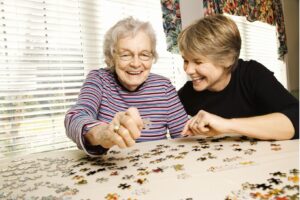Uniting consumers and in-home healthcare technology providers isn’t just a two-way street, it’s the intersection where consumers, insurance providers, employers, eldercare agencies, and caregivers come together to get these vital technologies to the people that can use them to enjoy a healthier, happier, and more independent lifestyle. As a home caregiver, you can take the independent initiative to seek out new technologies by getting in touch with your local healthcare agency, capitalizing on web-based resources, and communicating with your doctor about which technologies you and your loved one feel would serve them best.
Intermediary Organizations Connect Companies and Caregivers
Eldercare organizations play a vital role in connecting caregivers and older adults to resources, including new technology to improve home healthcare, from the latest fall-alert systems, to healthcare-tracking apps, health data monitoring services, or even in-home robots. The companies that develop these technologies are now recognizing eldercare groups as a way to connect with their users, and using resources like the U.S. Administration on Aging’s Eldercare Locator to connect with local agencies. Building partnerships with organizations—like IOA—can raise awareness that their product exists, and bring it to the people who need it.
For caregivers and older adults, this means that you can reach out to these organizations to find out about new developments for in-home healthcare, and ask to learn more about technologies that would help with your particular lifestyle requirements.
Internet Gives Caregivers and Tech Users Freedom of Choice & Knowledge of Options
Our older generation is the fastest-growing demographic when it comes to Internet usage, and they are using it to shop—adults aged 65+ spend upwards of $7 billion online each year. This is a fantastic development that makes for much more effective homecare technology distribution, because individuals can shop around for products that they think would be helpful for them, read product reviews, and even seek out secondary medical opinions online.
Web-based product review sites like Smart Elder Care provide product reviews of new technologies in a way that is easy to read, and easy to shop. This site combines product reviews, customer insights, technical specs, and nice photography—like a very enjoyable magazine article—that points you toward helpful products. iMedicalApps provides a similar platform for review in an easy-to-read format, but focuses on the healthcare apps that are available.
In addition to shopping for new technologies, online industry journals make it possible to shop around for second healthcare opinions and find out about new developments in homecare technology. Web-based healthcare technology journals like Dove Press make the latest industry developments available for anyone to read online, giving older adults and their caregivers greater freedom to explore the costs and benefits of different technologies. When you have access to the same base of knowledge that your healthcare provider does, you can have a much more informed opinion about which technologies you and your loved one want to invest in, and which you don’t. Digital health startups like Grand Rounds Health can also help patients develop an informed and independent opinion about their own healthcare; this site connects users to second opinions for care, so that patients can access a wider range of knowledge upon which to develop their healthcare preferences.
Writing Technology Into Your Prescription
Of course, no matter how informed you may be as a patient or caregiver, your doctor still plays a vital part in developing and prescribing an effective healthcare routine for patients, and today’s physicians are taking an active role in connecting older adults to the Silicon Valley innovators whose technologies are improving the experience of aging. So much so, in fact, that the next prescription your doctor writes you might very well be a prescription for a healthcare app. According to Mohit Kaushal, a doctor as well as partner in SF venture capital firm Aberdare Ventures, “the mobile health world has been around for a couple of years, and we’ve had a lot of experimentation and there are a lot of apps out there. So, it’s not surprising that a subset of these apps are quite valuable and that doctors are recommending them.” Manhattan Research also reports the growing trend of app ‘prescriptions’: “40% of physicians now believe that digital communications technologies of various kinds—including mobile apps, remote patient monitoring, secure messaging via patient portals, and telehealth consults—can help improve patient outcomes.”
As a caregiver or patient, you can take your own knowledge you’ve gained from doing your research on web-based journals and product reviews, and share with your doctor your perspective on which aging technologies you’re interested in making use of—the same online app-rating websites like Wellocracy that doctors use in deciding which apps to prescribe are available to you as a patient or caregiver. Staying informed makes for a collaborative approach to healthcare, where patients, doctors, and Silicon Valley are all working together for the greater good.
A Collaborative Effort to Connect Caregivers to New Tech
Sometimes it seems like new technologies for in-home healthcare are changing so fast it’s hard to know what available options are on the market—but web-based resources and product reviews can give you a solid foundation of knowledge about new developments in the field, and give you the background information you need to open up a conversation with your doctor about introducing new in-home healthcare technologies into your care routine. This united effort on the part of customers, companies, and medical professionals is connecting the older generation with valuable homecare technology products and services, while connecting these companies with the population whose business they need to thrive and keep innovating to better serve their customers.
IOA is committed to connecting older adults and their caregivers with the resources and technologies they need for a healthy, happy, and independent lifestyle. Connect with us to learn more about our services.







